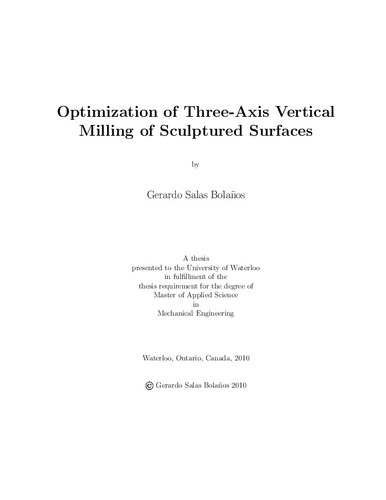| dc.contributor.author | Salas Bolanos, Gerardo | |
| dc.date.accessioned | 2010-05-12 13:32:41 (GMT) | |
| dc.date.available | 2010-05-12 13:32:41 (GMT) | |
| dc.date.issued | 2010-05-12T13:32:41Z | |
| dc.date.submitted | 2010 | |
| dc.identifier.uri | http://hdl.handle.net/10012/5164 | |
| dc.description.abstract | A tool path generation method for sculptured surfaces defined by triangular meshes is presented in this thesis along with an algorithm that helps determine the best type of cutter geometry to machine a specific surface.
Existing tool path planning methods for sculptured surfaces defined by triangular meshes require extensive computer processing power and result in long processing times mainly since surface topology for triangular meshes is not provided. The method presented in this thesis avoids this problem by offsetting each triangular facet individually.
The combination of all the individual offsets make up a cutter location surface. A single triangle offsetting results in many more triangles; many of these are redundant, increasing the time required for data handling in subsequent steps.
To avoid the large number of triangles, the proposed method creates a bounding space to which the offset surface is limited. The original surface mesh describes the bounding surface of a solid, thus it is continuous with no gaps. Therefore, the resulting bounding spaces are also continuous and without gaps. Applying the boundary space limits the size of the offset surface resulting in a reduction in the number of triangular surfaces generated. The offset surface generation may result in unwanted intersecting triangles. The tool path planning strategy addresses this issue by applying hidden-surface removal algorithms. The cutter locations from the offset surface are obtained using the depth buffer. The simulation and machining results show that the tool paths generated by this process are correct. Furthermore, the time required to generate tool paths is less than the time required by other methods.
The second part of this thesis presents a method for selecting an optimal cutter type. Extensive research has been carried out to determine the best cutter size for a given machining operation. However, cutter type selection has not been studied in-depth. This work presents a method for selecting the best cutter type based on the amount of material removed. By comparing the amount of material removed by two cutters at a given cutter location the best cutter can be selected. The results show that the optimal cutter is highly dependent on the surface geometry. For most complex surfaces it was found that a combination of cutters provides the best results. | en |
| dc.language.iso | en | en |
| dc.publisher | University of Waterloo | en |
| dc.subject | CNC machining | en |
| dc.subject | offset surface | en |
| dc.subject | tool selection | en |
| dc.subject | three axis | en |
| dc.subject | generalized cutter | en |
| dc.title | Optimization of Three-Axis Vertical Milling of Sculptured Surfaces | en |
| dc.type | Master Thesis | en |
| dc.pending | false | en |
| dc.subject.program | Mechanical Engineering | en |
| uws-etd.degree.department | Mechanical and Mechatronics Engineering | en |
| uws-etd.degree | Master of Applied Science | en |
| uws.typeOfResource | Text | en |
| uws.peerReviewStatus | Unreviewed | en |
| uws.scholarLevel | Graduate | en |

